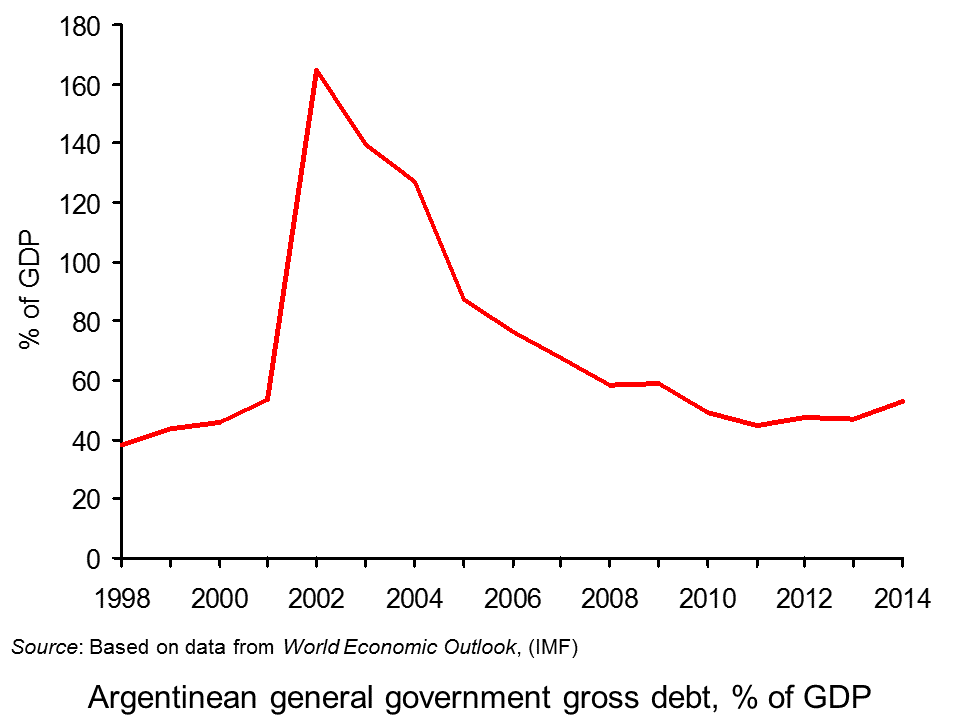 With talks ongoing about resolving the Greek debt crisis, it is clear that there is no agreement that will satisfy both sides – the Greek government and the troika of lenders (the IMF, the ECB and the European Commission). Their current negotiating positions are irreconcilable. What is needed is something more fundamental to provide a long-term solution. What is needed is a ‘deus ex machina‘.
With talks ongoing about resolving the Greek debt crisis, it is clear that there is no agreement that will satisfy both sides – the Greek government and the troika of lenders (the IMF, the ECB and the European Commission). Their current negotiating positions are irreconcilable. What is needed is something more fundamental to provide a long-term solution. What is needed is a ‘deus ex machina‘.
A deus ex machina, which is Latin for ‘god from a machine’, was a device used in Greek tragedy to solve an impossible situation. A god would appear from above, lowered by a crane, or from below through a trap door, and would put everything right. The tragedy would then be given a happy ending.
So what possible happy ending could be brought to the current Greek tragedy and who could be the deus ex machina?
 The negotiations between Greece and the troika currently centre on extending credit by €7.2bn when existing debts come up for repayment. There are repayments currently due to the IMF, or by the end of June, of €1.5bn and more in July, September and December (another €3.2bn). There are also €6.7bn of Greek bonds held by the ECB, as part of the 2010 bailout programme, that are due for repayment in July and August. Without the €7.2 billion bailout, Greece will be unable to meet these debt repayments, which also include Treasury bills.
The negotiations between Greece and the troika currently centre on extending credit by €7.2bn when existing debts come up for repayment. There are repayments currently due to the IMF, or by the end of June, of €1.5bn and more in July, September and December (another €3.2bn). There are also €6.7bn of Greek bonds held by the ECB, as part of the 2010 bailout programme, that are due for repayment in July and August. Without the €7.2 billion bailout, Greece will be unable to meet these debt repayments, which also include Treasury bills.
But the troika will only release the funds in return for harsh austerity measures, which involve further cuts to pensions and public expenditure. Greece would be required to run a substantial budget surplus for many years.
Greece could refuse, but then it would end up defaulting on debt and be forced out of the euro. The result would probably be a substantial depreciation of a newly restored drachma, rising inflation and many Greeks suffering even greater hardship – at least for a period of time.
 So what is the possible deus ex machina? If you’re looking for a ‘god’ then it is best, perhaps, to look beyond the current actors. Perhaps the Americans could play the role in finding a solution to the impasse. Perhaps a small group of independent experts or politicians, or both, could find one. In either case, the politics of the situation would have to be addressed as well as the economics and finance.
So what is the possible deus ex machina? If you’re looking for a ‘god’ then it is best, perhaps, to look beyond the current actors. Perhaps the Americans could play the role in finding a solution to the impasse. Perhaps a small group of independent experts or politicians, or both, could find one. In either case, the politics of the situation would have to be addressed as well as the economics and finance.
And what would be the ‘fix’ to satisfy both sides? Ultimately, this has to allow Greek debt to be sustainable without further depressing demand and undermining the fabric of Greek society.  This would almost certainly have to involve a large measure of debt forgiveness (i.e. debts being written off). It also has to avoid creating a moral hazard, whereby if the Greeks are seen as being ‘let off lightly’, this might encourage other indebted eurozone countries to be less willing to reduce their debts and make demands for forgiveness too.
This would almost certainly have to involve a large measure of debt forgiveness (i.e. debts being written off). It also has to avoid creating a moral hazard, whereby if the Greeks are seen as being ‘let off lightly’, this might encourage other indebted eurozone countries to be less willing to reduce their debts and make demands for forgiveness too.
Ultimately, the issue is a political one, not an economic one. This will require clever negotiation and, if there is a deus ex machina, clever mediation too.
Videos
 Greek PM Tsipras warns lenders bailout plans ‘not realistic’ BBC News, Jim Reynolds (5/6/25)
Greek PM Tsipras warns lenders bailout plans ‘not realistic’ BBC News, Jim Reynolds (5/6/25)
 Greece defers IMF payment until end of June BBC News, Chris Morris (5/6/15)
Greece defers IMF payment until end of June BBC News, Chris Morris (5/6/15)
 Greek debt talks: Empty shops and divided societies BBC News, Chris Morris (10/6/15)
Greek debt talks: Empty shops and divided societies BBC News, Chris Morris (10/6/15)
 Potential Grexit effects Deutsche Welle (13/6/15)
Potential Grexit effects Deutsche Welle (13/6/15)
Articles
It’s time to end the pretence: Greece will never fully repay its bailout loan The Guardian, Andrew Farlow (9/6/15)
Greek exit would trigger eurozone collapse, says Alexis Tsipras The Guardian, Phillip Inman, Helena Smith and Graeme Wearden (9/6/15)
The eurozone was a dream of unity. Now Europe has turned upon itself The Guardian, Business leader (14/6/15)
Greece bailout talks: an intractable crisis with three possible outcomes The Guardian, Larry Elliott (2/6/15)
Greece needs an economic defibrillator and a debt write-off Financial Times letters, Ray Kinsella (25/3/15)
Greece’s new debt restructuring plan Times of Change, Peter Spiegel (5/6/15)
Eurozone still in denial about Greece BBC News, Robert Peston (3/6/15)
Greece bailout talks – the main actors in a modern-day epic The Guardian, Phillip Inman, Ian Traynor and Helena Smith (9/6/15)
Greece isn’t any old troubled debtor BBC News, Robert Peston (15/6/15)
Greece in default if debt deadline missed, says Lagarde BBC News (18/6/15)
Burden of debt to IMF and European neighbours proves too much for Greece The Guardian, Heather Stewart (17/6/15)
Paper
Ending the Greek Crisis: Debt Management and Investment led Growth Greek government
Questions
- To which organisations is Greece indebted? What form to the debts take?
- To what extent is Greece’s current debt burden the result of design faults of the euro?
- Would it be possible to restructure debts in ways that make it easier for Greece to service them?
- Should Greece be treated by the IMF the same way it treated the highly indebted poor countries (HIPCs) and granted substantial debt relief?
- What would be the effects of Greek exit from the euro (a) for Greece; (b) for other eurozone countries?
- What bargaining chips can Greece deploy in the negotiations?
- Explain what is meant by ‘moral hazard’. Where in possible outcomes to the negotiations may there be moral hazard?
- What has been the impact of Greek austerity measures on the distribution of income and wealth in Greece?
- What are the practicalities of pursuing supply-side policies in Greece without further dampening aggregate demand?
 In the developed countries of 2015, extreme poverty is (or should be) a thing of the past. With well-developed welfare states and hence safety nets, no-one should be living in deep poverty. However, that is not the case across the rest of the world, where extreme poverty is still a common thing – though much reduced compared to a decade ago.
In the developed countries of 2015, extreme poverty is (or should be) a thing of the past. With well-developed welfare states and hence safety nets, no-one should be living in deep poverty. However, that is not the case across the rest of the world, where extreme poverty is still a common thing – though much reduced compared to a decade ago.
In the article linked below, Linda Yueh of the BBC asks whether it is possible to end global poverty. Looking at some of the key data, we are certainly moving in the right direction, with the poverty rate in the developing world halving since 1981. Projections suggest that ending global poverty by 2030 is possible, though it will require significant investment and commitment. The World Bank data indicates that 50 million people would need to be brought out of poverty every year. Economists, on the other hand, suggest that the poverty rate may have fallen to around 8% – still progress, but perhaps a more realistic target?
How we measure poverty is clearly important here, as the higher the threshold income required to be ‘out of poverty’, the longer it will take and the more people will currently be in poverty. It is also important to consider things like changes in the population as although more people may be brought out of poverty, if an even greater number of people are being born in a country, then it is entirely possible that poverty actually increases in absolute terms.
A key thing to bear in mind when it comes to reducing poverty is that there is no ‘one size fits all’ policy. What works in one country is not necessarily going to work in another country. Policies will have to be targeted to the needs of the population and this means more time and resources. The numbers are definitely moving in the right direction, but whether they are going quickly enough to meet the 2030 target is another story. The BBC News article is linked below, as are some interesting documents and items from the World Bank and United Nations.
Is it possible to end global poverty? BBC News, Linda Yueh (27/3/15)
Poverty will only end by 2030 if growth is shared World Bank, Espen Beer Prydz (19/11/14)
Far greater effort needed to eradicate extreme poverty in world’s poorest nations United Nations News Centre (23/10/14)
Ending Poverty and Sharing Prosperity World Bank Group and International Monetary Fund, Global Monitoring Report 2014/2015 2015
Questions
- What is poverty and how to we measure it?
- If the growth rate of the world is high, does this mean that poverty is falling?
- What factors have explained the success of China in reducing poverty? Why might similar policies be ineffective in Africa? What types of policies would you recommend to reduce global poverty in Sub-Saharan Africa?
- Does Aid or Debt Forgiveness from developed countries help poorer nations or could it create a moral hazard?
- How important is economic growth in eliminating global poverty?
- How important are the Millennium Development Goals in driving efforts to eradicate global poverty?
- What are the 3 elements that the Global Monitoring Report focuses on to make growth inclusive and sustainable? In each case, explain how the elements would contribute towards global efforts to end poverty.
 As we saw in the blog post last month, Eurozone becalmed the doldrums, the eurozone economy is stagnant and there is a growing danger that it could sink into a deflationary spiral. Last month, several new measures were announced by the ECB, including a negative interest rate on money deposited in the ECB by banks in the eurozone. This month, the ECB has gone further including, for the first time, a form of quantitative easing.
As we saw in the blog post last month, Eurozone becalmed the doldrums, the eurozone economy is stagnant and there is a growing danger that it could sink into a deflationary spiral. Last month, several new measures were announced by the ECB, including a negative interest rate on money deposited in the ECB by banks in the eurozone. This month, the ECB has gone further including, for the first time, a form of quantitative easing.
So what has been announced, and will it help to kick-start the eurozone economy? The measures were summarised by Mario Draghi, President of the ECB, at a press conference as follows:
The Governing Council decided today to lower the interest rate on the main refinancing operations of the Eurosystem by 10 basis points to 0.05% and the rate on the marginal lending facility by 10 basis points to 0.30%. The rate on the deposit facility was lowered by 10 basis points to –0.20%. In addition, the Governing Council decided to start purchasing non-financial private sector assets.
The Eurosystem will purchase a broad portfolio of simple and transparent asset-backed securities (ABSs) with underlying assets consisting of claims against the euro area non-financial private sector under an ABS purchase programme (ABSPP). This reflects the role of the ABS market in facilitating new credit flows to the economy and follows the intensification of preparatory work on this matter, as decided by the Governing Council in June. In parallel, the Eurosystem will also purchase a broad portfolio of euro-denominated covered bonds issued by MFIs domiciled in the euro area under a new covered bond purchase programme (CBPP3). Interventions under these programmes will start in October 2014.

To summarise: the ECB has cut interest rates, with the main rate cut to virtually zero (i.e. 0.05%). This represents a floor to interest rates, as, according to Mario Draghi, there is now no scope for further cuts. (Click here for a PowerPoint of the chart.)
In addition, the ECB will begin the outright purchase of private-sector securities. This is a form of quantitative easing as it will involve the purchase of assets with newly created money. In the past, the ECB has simply offered loans to banks, with assets owned by banks used as collateral. This form of quantitative easing has been dubbed ‘QE light’, as it does not involve the purchase of government bonds, something the German government in particular has resisted. The ECB recognises that it would be a sensitive matter to buy government bonds of countries, such as Greece, Spain and Cyprus, which have been criticised for excessive borrowing.
Nevertheless, if it involves the creation of new money, purchasing private-sector assets is indeed a form of QE. As Mario Draghi said in response to a question on this matter:
QE is an outright purchase of assets. To give an example: rather than accepting these assets as collateral for lending, the ECB would outright purchase these assets. That’s QE. It would inject money into the system. Now, QE can be private-sector asset-based, or also sovereign-sector, public-sector asset-based, or both. The components of today’s measures are predominantly oriented to credit easing. However, it’s quite clear that we would buy outright ABS only if there is a guarantee.
So with appropriate guarantees in place about the soundness of these securitised assets, the ECB will purchase them outright.
But will these measures be enough? Time will tell, but there are now several measures in the pipeline, which could see a large stimulus to bank lending. The main question is whether banks will indeed take the opportunity to lend or merely hoard the extra reserves. And that depends in large part on the demand for credit from businesses and consumers. Boosting that is difficult when the economic climate is pessimistic.
Articles
Draghi’s ECB surprise puts off bigger quantitative easing for now Reuters, John O’Donnell (5/9/14)
ECB President Mario Draghi pulls stimulus lever at last, but still no quantitative easing for eurozone Independent, Ben Chu (5/9/14)
ECB cuts rates and launches stimulus programme BBC News (4/9/14)
Draghi Push for ECB Easing Intensifies Focus on ABS Plan Bloomberg, Stefan Riecher and Jeff Black (4/9/14)
 Draghi Sees Almost $1 Trillion Stimulus as QE Fight Waits Bloomberg, Simon Kennedy (5/9/14)
Draghi Sees Almost $1 Trillion Stimulus as QE Fight Waits Bloomberg, Simon Kennedy (5/9/14)
Draghi’s Case For ECB Quantitative Easing Forbes, Jon Hartley (8/9/14)
ECB’s last roll of the dice BBC News, Robert Peston (4/9/14)
Draghi’s eurozone steroids BBC News, Robert Peston (2/10/14)
Draghinomics – Abenomics, European-style The Guardian, Nouriel Roubini (1/9/14)
ECB Press Release
Introductory statement to the press conference (with Q&A) European Central Bank, Mario Draghi, President of the ECB (4/9/14)
 Webcast of the press conference 4 September 2014 European Central Bank, Mario Draghi, President of the ECB (4/9/14)
Webcast of the press conference 4 September 2014 European Central Bank, Mario Draghi, President of the ECB (4/9/14)
Questions
- Summarise the ECB’s monetary policy measures that will be coming into effect over the coming months.
- How does the QE announced by Mario Draghi differ from the QE that has been used by the Bank of England?
- Would it be a realistic option for the ECB to reduce its main rate below zero, just as it did with the deposit facility rate?
- What is meant by ‘securitisation’. Explain how asset-backed securities (ABSs) and covered bonds are forms of securitised assets.
- Why will the purchase of mortgage-backed securities not necessarily give a boost to the housing market?
- How does the effectiveness of any QE programme depend on what happens to the velocity of circulation of created money?
- What determines this velocity of circulation?
- Why are ‘animal spirits’ so important in determining the effectiveness of monetary policy?
- Are there any moral hazards in the ECB actions? If so what are they?
 An historic agreement has been reached between Argentina over outstanding debt owed to creditor nations. Creditor nations come together as the ‘Paris Club’ and at a Paris Club meeting on May 28, details of a repayment plan were agreed. Argentina hopes that the agreement will enable it to start borrowing again on international markets: something that had been largely blocked by outstanding debt, which, up to now, Argentina had been unwilling to repay.
An historic agreement has been reached between Argentina over outstanding debt owed to creditor nations. Creditor nations come together as the ‘Paris Club’ and at a Paris Club meeting on May 28, details of a repayment plan were agreed. Argentina hopes that the agreement will enable it to start borrowing again on international markets: something that had been largely blocked by outstanding debt, which, up to now, Argentina had been unwilling to repay.
The problem goes back to 2001. Argentina was faced with international debt payments of $132bn, equalling some 27% of GDP and over 300% of export earnings. But at the time the country was in recession and debts were virtually impossible to service. It had received some help from the International Monetary Fund, but in December 2001, the IMF refused a request for a fresh loan of $1.3 billion
As Case Study 27.5 in MyEconLab for Economics, 8th edition explains:
This triggered a crisis in the country with mass rioting and looting. As the crisis deepened, Argentina announced that it was defaulting on its $166 billion of foreign debt. This hardly came as a surprise, however. For many commentators, it was simply a question of when.
This hardly came as a surprise, however. For many commentators, it was simply a question of when.
Argentina’s default on its debts was the biggest of its kind in history. In a series of dramatic measures, the Argentine peso was initially devalued by 29%. Over the next three months, the peso depreciated a further 40%.
The economy seemed in free-fall. GDP fell by 11% in 2002 and, by the end of the year, income per head was 22% below that of 1998. Unemployment was 21%.
Then, however, the economy began to recover, helped by higher (peso) prices for exports resulting from the currency depreciation. In 2003 economic growth was 9.0% and averaged 8.4% per annum from 2004 to 2008.
But what of the debt? In 2005, Argentina successfully made a huge debt swap with banks and other private creditors (see Box 27.1 in Economics, 8th edition). A large proportion of its defaulted debt was in the form of bonds. It offered to swap the old bonds for new peso bonds, but worth only 35% as much (known as a ‘haircut’). By the deadline of 25 February, there was a 76% take-up of the offer: clearly people thought that 35% was better than nothing! At a stroke, bonds originally worth $104 billion now became worth just $36.2 billion. Later the take-up of the offer increased to 93%. But still 7% held out.
Then in 2006 its debt of nearly $10 billion was repaid to the IMF. General government debt stock as a percentage of GDP fell from 172% in 2002 to 106% in 2006 and to 48% in 2010.
In September 2008, the government of President Cristina Kirchner pledged to use some of its foreign currency reserves of $47 billion to pay back the remainder of the defaulted debt still owed to Paris Club creditors. But negotiations stalled.
However, at the Paris Club meeting of 28 May this year, agreement was finally reached. Argentina will repay the outstanding $9.7bn owed to individual creditor countries. This will take place over 5 years, with a first instalment of $1.15bn being paid before May 2015.
Argentina hopes that the agreement will open up access to overseas credit, which, up to now, has been limited because of this unresolved debt. However, Argentina still owes money to the holders of the 7% of bonds who did not accept the haircut offered in 2005. Their claims are being heard in the US Supreme Court on 12 June this year. The outcome will be critical in determining whether Argentina will be able to raise new funds on the bond market.
Argentina clinches landmark debt repayment deal with Paris Club Reuters, Leigh Thomas and Sarah Marsh (29/5/14)
Argentina Will Repay Paris Club Debt 13 Years After Default Bloomberg, Charlie Devereux and Pablo Gonzalez (29/5/14)
Argentina and the capital markets: At least they have Paris The Economist (30/5/14)
Argentina’s Paris Club Deal to Bring Investment, Kicillof Says Bloomberg, Charlie Devereux (30/5/14)
Argentina Leaves Singer for Last in Preparing Bond Market Return Bloomberg BusinessWeek, Camila Russo and Katia Porzecanski (30/5/14)
Argentina in deal with Paris Club to pay $10bn debts BBC News (29/5/14)
Argentina debt deal could help ease re-entry to international markets The Guardian (29/5/14)
Argentina agrees deal to pay back $10bn debt The Telegraph (29/5/14)
Questions
- What is the Paris Club? Why did the recent meeting of the Paris Club concerning Argentina’s debt not include the IMF?
- What moral hazards are involved in (a) defaulting on debt; (b) offering debt relief to debtor countries; (c) agreeing to pay bond holders who did not accept the haircut?
- In hindsight, was it in Argentina’s interests to default on its international debts in 2001?
- Assume a country has a severe debt problem. What are the benefits and costs of using devaluation (or depreciation) to tackle the problem?
 In his Budget on March 19, the Chancellor of the Exchequer, George Osborne, announced fundamental changes to the way people access their pensions. Previously, many people with pension savings were forced to buy an annuity. These pay a set amount of income per month from retirement for the remainder of a person’s life.
In his Budget on March 19, the Chancellor of the Exchequer, George Osborne, announced fundamental changes to the way people access their pensions. Previously, many people with pension savings were forced to buy an annuity. These pay a set amount of income per month from retirement for the remainder of a person’s life.
But, with annuity rates (along with other interest rates) being at historically low levels, many pensioners have struggled to make ends meet. Even those whose pension pots did not require them to buy an annuity were limited in the amount they could withdraw each year unless they had other guaranteed income of over £20,000.
Now pensioners will no longer be required to buy an annuity and they will have much greater flexibility in accessing their pensions. As the Treasury website states:
This means that people can choose how they access their defined contribution pension savings; for example they could take all their pension savings as a lump sum, draw them down over time, or buy an annuity.
While many have greeted the news as a liberation of the pensions market, there is also the worry that this has created a moral hazard.  When people retire, will they be tempted to blow their savings on foreign travel, a new car or other luxuries? And then, when their pension pot has dwindled and their health is failing, will they then be forced to rely on the state to fund their care?
When people retire, will they be tempted to blow their savings on foreign travel, a new car or other luxuries? And then, when their pension pot has dwindled and their health is failing, will they then be forced to rely on the state to fund their care?
But even if pensioners resist the urge to go on an immediate spending spree, there are still large risks in giving people the freedom to spend their pension savings as they choose. As the Scotsman article below states:
The risks are all too obvious. Behaviour will change. People who no longer have to buy an annuity will not do so but will then be left with a pile of cash. What to do with it? Spend it? Invest it? There are many new risky choices. But the biggest of all can be summed up in one fact: when we retire our life expectancy continues to grow. For every day we live after 65 it increases by six and a half hours. That’s right – an extra two-and-a-half years every decade.
The glory of an annuity is it pays you an income for every year you live – no matter how long. The problem with cash is that it runs out. Already the respected Institute for Fiscal Studies (IFS) has said that the reform ‘depends on highly uncertain behavioural assumptions about when people take the money’. And that ‘there is a market failure here. There will be losers from this policy’.
We do not have perfect knowledge about how long we will live or even how long we can be expected to live given our circumstances. Many people are likely to suffer from a form of myopia that makes them blind to the future: “We’re likely to be dead before the money has run out”; or “Let’s enjoy ourselves now while we still can”; or “We’ll worry about the future when it comes”.
The point is that there are various market failings in the market for pensions and savings. Will the decisions of the Chancellor have made them better or worse?
Articles
Pension shakeup in budget leaves £14bn annuities industry reeling The Guardian, Patrick Collinson (20/3/14)
Chancellor vows to scrap compulsory annuities in pensions overhaul The Guardian, Patrick Collinson and Harriet Meyer (19/3/14)
Labour backs principle of George Osborne’s pension shakeup The Guardian, Rowena Mason (23/3/14)
Osborne’s pensions overhaul may mean there is little left for future rainy days The Guardian, Phillip Inman (24/3/14)
Let’s celebrate the Chancellor’s bravery on pensions – now perhaps the Government can tackle other mighty vested interests Independent on Sunday, Mary Dejevsky (23/3/14)
A vote-buying Budget The Scotsman, John McTernan (21/3/14)
L&G warns on mis-selling risks of pension changes The Telegraph, Alistair Osborne (26/3/14)
Budget 2014: Pension firms stabilise after £5 billion sell off Interactive Investor, Ceri Jones (20/3/14)
Budget publications
Budget 2014: pensions and saving policies Institute for Fiscal Studies, Carl Emmerson (20/3/14)
Budget 2014: documents HM Treasury (March 2014)
Freedom and choice in pensions HM Treasury (March 2014)
Questions
- What market failures are there in the market for pensions?
- To what extent will the new measures help to tackle the existing market failures in the pension industry?
- Explain the concept of moral hazard. To what extent will the new pension arrangements create a moral hazard?
- Who will be the losers from the new arrangements?
- Assume that you have a choice of how much to pay into a pension scheme. What is likely to determine how much you will choose to pay?
 With talks ongoing about resolving the Greek debt crisis, it is clear that there is no agreement that will satisfy both sides – the Greek government and the troika of lenders (the IMF, the ECB and the European Commission). Their current negotiating positions are irreconcilable. What is needed is something more fundamental to provide a long-term solution. What is needed is a ‘deus ex machina‘.
With talks ongoing about resolving the Greek debt crisis, it is clear that there is no agreement that will satisfy both sides – the Greek government and the troika of lenders (the IMF, the ECB and the European Commission). Their current negotiating positions are irreconcilable. What is needed is something more fundamental to provide a long-term solution. What is needed is a ‘deus ex machina‘. The negotiations between Greece and the troika currently centre on extending credit by €7.2bn when existing debts come up for repayment. There are repayments currently due to the IMF, or by the end of June, of €1.5bn and more in July, September and December (another €3.2bn). There are also €6.7bn of Greek bonds held by the ECB, as part of the 2010 bailout programme, that are due for repayment in July and August. Without the €7.2 billion bailout, Greece will be unable to meet these debt repayments, which also include Treasury bills.
The negotiations between Greece and the troika currently centre on extending credit by €7.2bn when existing debts come up for repayment. There are repayments currently due to the IMF, or by the end of June, of €1.5bn and more in July, September and December (another €3.2bn). There are also €6.7bn of Greek bonds held by the ECB, as part of the 2010 bailout programme, that are due for repayment in July and August. Without the €7.2 billion bailout, Greece will be unable to meet these debt repayments, which also include Treasury bills. So what is the possible deus ex machina? If you’re looking for a ‘god’ then it is best, perhaps, to look beyond the current actors. Perhaps the Americans could play the role in finding a solution to the impasse. Perhaps a small group of independent experts or politicians, or both, could find one. In either case, the politics of the situation would have to be addressed as well as the economics and finance.
So what is the possible deus ex machina? If you’re looking for a ‘god’ then it is best, perhaps, to look beyond the current actors. Perhaps the Americans could play the role in finding a solution to the impasse. Perhaps a small group of independent experts or politicians, or both, could find one. In either case, the politics of the situation would have to be addressed as well as the economics and finance. This would almost certainly have to involve a large measure of debt forgiveness (i.e. debts being written off). It also has to avoid creating a moral hazard, whereby if the Greeks are seen as being ‘let off lightly’, this might encourage other indebted eurozone countries to be less willing to reduce their debts and make demands for forgiveness too.
This would almost certainly have to involve a large measure of debt forgiveness (i.e. debts being written off). It also has to avoid creating a moral hazard, whereby if the Greeks are seen as being ‘let off lightly’, this might encourage other indebted eurozone countries to be less willing to reduce their debts and make demands for forgiveness too. Greek PM Tsipras warns lenders bailout plans ‘not realistic’ BBC News, Jim Reynolds (5/6/25)
Greek PM Tsipras warns lenders bailout plans ‘not realistic’ BBC News, Jim Reynolds (5/6/25) Greece defers IMF payment until end of June BBC News, Chris Morris (5/6/15)
Greece defers IMF payment until end of June BBC News, Chris Morris (5/6/15) Greek debt talks: Empty shops and divided societies BBC News, Chris Morris (10/6/15)
Greek debt talks: Empty shops and divided societies BBC News, Chris Morris (10/6/15) Potential Grexit effects Deutsche Welle (13/6/15)
Potential Grexit effects Deutsche Welle (13/6/15)





